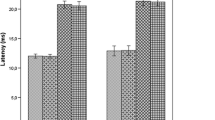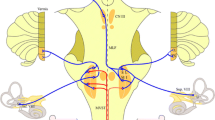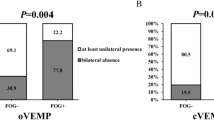Abstract
Background
The vestibular evoked myogenic potential (VEMP) is a technique used to assess vestibular function. Cervical VEMPs (cVEMPs) are obtained conventionally from the sternocleidomastoid (SCM) muscle; however, the dorsal neck muscle splenius capitis (SPL) has also been shown to be a reliable target alongside the SCM in young subjects.
Objective
This study aimed to compare cVEMPs from the SCM and SPL in two positions across young, older, and Parkinson’s disease (PD) patients.
Method
Experiments were carried out using surface EMG electrodes placed over the SCM and SPL. cVEMPs were measured using a 30 s, 126 dB sound stimulus with 222 individual tone bursts, while subjects were in a supine and head-turned posture (also known as the head elevation method), and in a seated head-turned posture.
Results
When comparing cVEMPs across positions, the incidence of supine and seated SCM-cVEMPs diminished significantly in older and PD patients in comparison with young subjects. However, no statistically significant differences in incidences were found in seated SPL-cVEMPs when comparing young, older and PD patients. SPL-cVEMPs were present significantly more often than seated SCM-cVEMPs in PD patients.
Conclusions
SPL-cVEMPs are not altered to the same extent that SCM-cVEMPs are by aging and disease and its addition to cVEMP testing may reduce false-positive tests for vestibulopathy.






Similar content being viewed by others
Abbreviations
- VEMPs:
-
Vestibular evoked myogenic potentials
- SCM:
-
Sternocleidomastoid
- cVEMPs:
-
Cervical vestibular evoked myogenic potentials
- SPL:
-
Splenius capitis
- MG:
-
Medial gastrocnemius
- TIB:
-
Tibialis anterior
- SCM-cVEMP:
-
Cervical vestibular evoked myogenic potential measured from the sternocleidomastoid
- PD:
-
Parkinson’s disease
- SPL-cVEMP:
-
Cervical vestibular evoked myogenic potentials measured from the splenius capitis
- EMG:
-
Electromyography
- MD:
-
Meniere’s disease
- PSP:
-
Progressive supranuclear palsy
References
Halmagyi GM, Curthoys IS (1999) Clinical testing of otolith function. Ann NY Acad Sci 871:195–204
Welgampola MS, Colebatch JG (2005) Characteristics and clinical applications of vestibular-evoked myogenic potentials. Neurology 64(10):1682–1688. https://doi.org/10.1212/01.WNL.0000161876.20552.AA
Gulec F, Celebisoy N, Kose T (2013) Vestibular evoked myogenic potentials in splenius capitis muscle. J Int Adv Otol 9(1):96
Camp AJ, Gu C, Cushing SL, Gordon KA, Corneil BD (2017) Splenius capitis is a reliable target for measuring cervical vestibular evoked myogenic potentials in adults. Eur J Neurosci. doi:10.1111/ejn.13536
Naranjo EN, Allum JH, Inglis JT, Carpenter MG (2015) Increased gain of vestibulospinal potentials evoked in neck and leg muscles when standing under height-induced postural threat. Neuroscience 293:45–54. https://doi.org/10.1016/j.neuroscience.2015.02.026
Caporali JF, Utsch Goncalves D, Labanca L, Dornas de Oliveira L, de Melo Vaz, Trindade G, de Almeida Pereira T, Diniz Cunha PH, Santos Falci Mourao M, Lambertucci JR (2016) Vestibular evoked myogenic potential (VEMP) triggered by galvanic vestibular stimulation (GVS): a promising tool to assess spinal cord function in schistosomal myeloradiculopathy. PLoS Negl Trop Dis 10(4):e0004672. https://doi.org/10.1371/journal.pntd.0004672
Eleftheriadou A, Koudounarakis E (2011) Vestibular-evoked myogenic potentials eliciting: an overview. Eur Arch Otorhinolaryngol 268(3):331–339. https://doi.org/10.1007/s00405-010-1408-7
Sakakura K, Takahashi K, Takayasu Y, Chikamatsu K, Furuya N (2005) Novel method for recording vestibular evoked myogenic potential: minimally invasive recording on neck extensor muscles. Laryngoscope 115(10):1768–1773. https://doi.org/10.1097/01.mlg.0000173157.34039.d8
Su HC, Huang TW, Young YH, Cheng PW (2004) Aging effect on vestibular evoked myogenic potential. Otol Neurotol 25(6):977–980
Rosengren SM, Weber KP, Govender S, Welgampola MS, Dennis DL, Colebatch JG (2019) Sound-evoked vestibular projections to the splenius capitis in humans: comparison with the sternocleidomastoid muscle. J Appl Physiol (1985). https://doi.org/10.1152/japplphysiol.00711.2018
Colebatch JG, Day BL, Bronstein AM, Davies RA, Gresty MA, Luxon LM, Rothwell JC (1998) Vestibular hypersensitivity to clicks is characteristic of the Tullio phenomenon. J Neurol Neurosurg Psychiatry 65(5):670–678
Venhovens J, Meulstee J, Bloem BR, Verhagen WI (2016) Neurovestibular analysis and falls in Parkinson's disease and atypical parkinsonism. Eur J Neurosci 43(12):1636–1646. https://doi.org/10.1111/ejn.13253
de Natale ER, Ginatempo F, Paulus KS, Manca A, Mercante B, Pes GM, Agnetti V, Tolu E, Deriu F (2015) Paired neurophysiological and clinical study of the brainstem at different stages of Parkinson's Disease. Clin Neurophysiol 126(10):1871–1878. https://doi.org/10.1016/j.clinph.2014.12.017
de Natale ER, Ginatempo F, Paulus KS, Pes GM, Manca A, Tolu E, Agnetti V, Deriu F (2015) Abnormalities of vestibular-evoked myogenic potentials in idiopathic Parkinson's disease are associated with clinical evidence of brainstem involvement. Neurol Sci 36(6):995–1001. https://doi.org/10.1007/s10072-014-2054-4
Kamibayashi LK, Richmond FJR (1998) Morphometry of human neck muscles. Spine 23(12):1314–1323. https://doi.org/10.1097/00007632-199806150-00005
Rosengren SM, Colebatch JG, Borire A, Straumann D, Weber KP (2016) cVEMP morphology changes with recording electrode position, but single motor unit activity remains constant. J Appl Physiol (1985) 120(8):833–842. https://doi.org/10.1152/japplphysiol.00917.2015
Benhamou MA, Revel M, Vallee C (1995) Surface electrodes are not appropriate to record selective myoelectric activity of splenius capitis muscle in humans. Exp Brain Res 105(3):432–438
Colebatch JG, Halmagyi GM, Skuse NF (1994) Myogenic potentials generated by a click-evoked vestibulocollic reflex. J Neurol Neurosurg Psychiatry 57(2):190–197
Rosengren SM (2015) Effects of muscle contraction on cervical vestibular evoked myogenic potentials in normal subjects. Clin Neurophysiol 126(11):2198–2206. https://doi.org/10.1016/j.clinph.2014.12.027
Colebatch JG, Halmagyi GM (1992) Vestibular evoked potentials in human neck muscles before and after unilateral vestibular deafferentation. Neurology 42(8):1635–1636
Wang CT, Young YH (2006) Comparison of the head elevation versus rotation methods in eliciting vestibular evoked myogenic potentials. Ear Heart 27(4):376–381. https://doi.org/10.1097/01.aud.0000224126.24604.db
Ozdek A, Tulgar M, Saylam G, Tatar E, Korkmaz H (2009) Comparison of head rotation versus head elevation methods for vestibular evoked myogenic potentials by using logon stimulus. Int J Pediatr Otorhinolaryngol 73(5):645–649. https://doi.org/10.1016/j.ijporl.2008.12.023
Wei W, Jeffcoat B, Mustain W, Zhu H, Eby T, Zhou W (2013) Frequency tuning of the cervical vestibular-evoked myogenic potential (cVEMP) recorded from multiple sites along the sternocleidomastoid muscle in normal human subjects. J Assoc Res Otolaryngol 14(1):37–47. https://doi.org/10.1007/s10162-012-0360-1
Ashford A, Huang J, Zhang C, Wei W, Mustain W, Eby T, Zhu H, Zhou W (2016) The cervical vestibular-evoked myogenic potentials (cVEMPs) Recorded along the sternocleidomastoid muscles during head rotation and flexion in normal human subjects. J Assoc Res Otolaryngol 17(4):303–311. https://doi.org/10.1007/s10162-016-0566-8
Wilson VJ, Boyle R, Fukushima K, Rose PK, Shinoda Y, Sugiuchi Y, Uchino Y (1995) The vestibulocollic reflex. J Vestib Res 5(3):147–170
Wu CH, Young YH, Murofushi T (1999) Tone burst-evoked myogenic potentials in human neck flexor and extensor. Acta Otolaryngol 119(7):741–744
Murofushi T (2016) Clinical application of vestibular evoked myogenic potential (VEMP). Auris Nasus Larynx 43(4):367–376. https://doi.org/10.1016/j.anl.2015.12.006
Rosengren SM, Govender S, Colebatch JG (2011) Ocular and cervical vestibular evoked myogenic potentials produced by air- and bone-conducted stimuli: comparative properties and effects of age. Clin Neurophysiol 122(11):2282–2289. https://doi.org/10.1016/j.clinph.2011.04.001
Brantberg K, Granath K, Schart N (2007) Age-related changes in vestibular evoked myogenic potentials. Audiol Neurootol 12(4):247–253. https://doi.org/10.1159/000101332
Venhovens J, Meulstee J, Verhagen WI (2016) Vestibular evoked myogenic potentials (VEMPs) in central neurological disorders. Clin Neurophysiol 127(1):40–49. https://doi.org/10.1016/j.clinph.2014.12.021
Acknowledgements
The authors would like to acknowledge Ms Miranda Mathews and Mr Max Mo for assistance with data collection, and Dr. Ala Ali for sourcing of subjects and patients.
Author information
Authors and Affiliations
Corresponding author
Ethics declarations
Conflict of interest
The authors declare that they have no conflict of interest.
Research involving humans and animal rights
This study was carried out in accordance with the recommendations of the National Health and Medical Research Council of Australia’s statement on ethical conduct in research (2015) with approval from the Human Research Ethics Committee of the University of Sydney (2017/082).
Informed consent
All subjects gave written informed consent in accordance with the Declaration of Helsinki.
Additional information
Publisher's Note
Springer Nature remains neutral with regard to jurisdictional claims in published maps and institutional affiliations.
Electronic supplementary material
Below is the link to the electronic supplementary material.
Rights and permissions
About this article
Cite this article
Mohammed Ali, F., Westling, M., Zhao, L.H.L. et al. Splenius capitis: sensitive target for the cVEMP in older and neurodegenerative patients. Eur Arch Otorhinolaryngol 276, 2991–3003 (2019). https://doi.org/10.1007/s00405-019-05582-7
Received:
Accepted:
Published:
Issue Date:
DOI: https://doi.org/10.1007/s00405-019-05582-7




